Track is a fundamental component of the railroad. The structure and function
of tracks are fairly simple, but they must be clearly understood if we are
to fully comprehend railway maintenance and the tasks required of railway
maintenance equipment.
Railroad track is designed to guide the train while
evenly distributing its weight and providing adequate drainage. Track must
be flexible and responsive to the effects of a variety of weather conditions.
It must accomplish these functions as economically and as simply as possible,
while remaining easy to maintain.
The guiding function of tracks is fairly obvious. The tracks provide a
smooth, unbroken running surface.
Wheels run on the rails and are held
in place by the weight of the train, which puts vertical pressure on them.
Flanges located on the inside dimension of the wheels prevent lateral movement
beyond the track.
FYI: Continuous welded rail adds a level of maintenance difficulty when a defect is located. The defective segment must be physically cut out and replaced with a new section. Welders often use a portable welding kit to repair track.
The tracks’ function or weight distribution is less apparent, but equally
important. It is easier to understand how weight transferal works if the
whole track structure is viewed as a pyramid, starting with the rails on
top, and working down through the different components in order of their
placement rails, tie plates, ties, ballast, sub-ballast, and sub-grade.
Each component transfers and distributes the weight of the passing train
over a greater area, beginning with the wheel-rail contact point and continuing
all the way down to the sub-ballast and the ground below, known as the
sub-grade. The failure of any of these components can result in the collapse
of the track structure.
Monitoring the condition of the track and all its components is an essential part of effective railway maintenance.
The railway inspectors must look for signs of defects that may reveal more serious problems. Rail way maintenance aims to keep the track structure in shape to carry the load it is designed for.
Track and railroad videos
New Railways Track Construction Machine
TECSA SYSTEM of High Speed Railway Track Mounting--- Published on Oct 11, 2014 --TECSA SYSTEM of High Speed Railway Track Mounting is an innovative development in the world of railway track constructión. Developed by TECSA SA since 2006 it has become the standard in HSR track mounting due to the incredible improvement of the track mounting.
Rail welding plant (Geismar--english)
Sleeper track-replacement method (Geismar--english)
Early History
The basic components of modern track were established more than 200 years ago in Britain by early tram lines, the primitive industrial railways. Over the years, the size and composition of the track components have evolved to reflect the development of more modern materials and the need to support ever faster and heavier trains. So while modern track has a common structure with tracks from the early railways, the materials used for track have changed.
Primitive tracks on British tram railways were composed of wooden rails set on wooden sleepers (known in America as crossties); some lines used stone blocks instead of wood. Sleepers rested on a crude sub-grade support that was often little more than bare earth. Strings of four-wheel tram carts were hauled along the tracks by horses or oxen. Originally the rails were flanged rather than the wheels. Later wheels were flanged, but initially the flange was on the outside rim of the wheel, rather than on the inside as they are today. Wheeled carts pulled on rails offered a more efficient way of hauling heavy loads than on conventional rutted roads. Animals could haul greater loads using a fixed track, which avoided problems of ruts and mud. In the early part of the nineteenth century, the first steam locomotives were built to supplement animal teams on tram rail ways. Since the engines were much heavier than loaded wagons, the track structure needed strengthening to accommodate them.
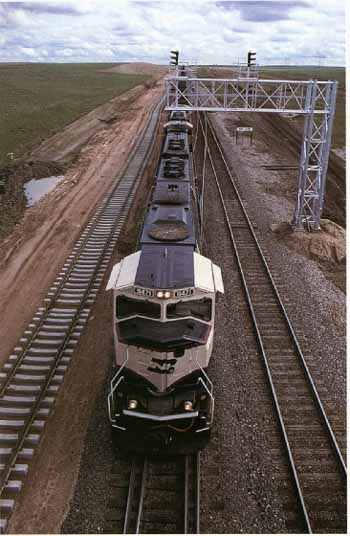
Track serves a number of important functions, not
only guiding the train but also distributing its weight. A laden coal
train, such as this one, can weigh as much as 15,000 tons, so proper
weight distribution is imperative. On the left, the newly laid track with continuous
welded rail and concrete ties will need to be ballasted, aligned, and
tamped before it is ready for traffic.
Track Gauge
Some early British tram lines used a 5 foot outside track width, or track gauge. The inside measurement of this track gauge was roughly 4 feet, 8.5 inches. (In the early days, the distance between the rails—known as track gauge—was measured from the outside distance between the rails today we measure gauge as the inside distance between the rails.) In the early I 820s, rail way pioneer George Stephenson adopted this width for his Stockton & Darlington line, the world’s first steam powered public railway. Stephenson’s chosen gauge was subsequently adopted by most railway lines in Britain. Since early American railways took their cues from British practice, and frequently imported their locomotives from Britain, many early American lines also used the track gauge of 4 feet, 8.5 inches. There were many exceptions to this standard over the years, but the Stephenson Standard is now the most common gauge in Europe, America, and many countries around the world.
Track gauge is one of the few constants in railway practice, linking modern railways with the very earliest steam-powered lines. While just about everything else has changed, from the motive power to the way railroads operate, the track width remains the same. Some of the earliest pre served locomotives, such as the Robert Stephenson & Company’s Rocket, built in 1829, or the John Bull, built in 1831, for export to the Camden & Amboy in New Jersey, could operate on modern tracks.
Rail
Early rails were little more than wooden beams. The addition of thin iron straps nailed to the top of the rails was one of the first improvements designed to prolong the life of the rails and reduce the chance of their snapping under loads. The emergence of locomotives, even the small early machines built for tram lines, required heavier, more durable rails than those used strictly for animal-powered lines. Solid iron rails were developed that were safer and more durable than wooden strap-iron rails. In Britain, early steam railways employed several different types of heavy cast-iron rails. One of the most common was descriptively known as a “fish belly” for its distinctive shape; it was thin at the ends and fat in the middle. American railways were not as enthusiastic about these heavy cast-iron designs, partly because of the high cost of manufacturing and importing them from Britain.
In 1831, Camden & Amboy’s Robert Stevens designed an improved style of iron rail that featured a profile resembling the letter “I” or an inverted “T,” commonly known as the “Tee rail” because of its shape. This rail style has a broad thin base with a thin neck (sometimes described as a web) and a narrow-width thick head. The Tee rail was originally made from cast or wrought iron and could be easily produced domestically, making it popular with early lines in the United States. The Tee rail demonstrated durability, versatility, and cost effectiveness, and in the 170 years since it was introduced, it has be come the most common style of rail in the world, replacing most other varieties. Though the Tee rail has undergone a variety of compositional changes, its essential structure remains basically unaltered.
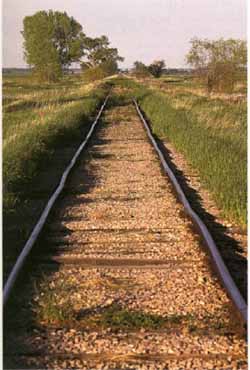
Track that isn’t properly maintained gradually
deteriorates to the point that trains have to operate extremely slowly
to avoid derailment. This section is suffering from low joints, badly
fouled ballast, and rotting ties. The track was still being used when
this photo was taken in May 1995, albeit with a maximum track speed of
5 miles per hour.
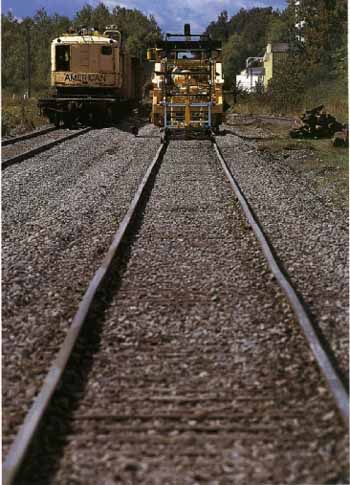
Replacing ties, adding ballast, and aligning track
in conjunction with tamping. This track has just been worked over by
a ballast regulator and is about to be aligned with a tamper.
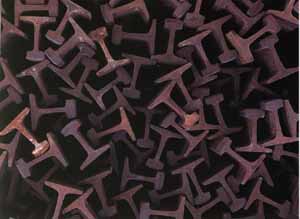
The Tee rail is the standard rail design used
throughout North America and the world. The basic profile
of the Tee rail remains the same, but its size and weight can vary greatly
depending on the type and quantity of traffic it is intended to support.
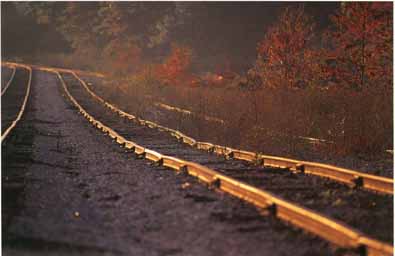
The joint is one of the weakest parts of the track
structure and is often the cause of continual maintenance headaches.
This photo illustrates the effect of low joints resulting from poor maintenance.
The early Tee rails made from iron were much smaller and lighter than those used today. Wrought-iron rails were brittle because of their high carbon content and were prone to snapping under heavy loads. During the last quarter of the nineteenth century, the introduction of inexpensive steel, manufactured by the Bessemer and open- hearth processes, allowed the production of relatively cheap steel rails. These were considerably more durable than rails fashioned from rolled iron. Today, rails are rolled from high-quality modern alloy steels and use much heavier profiles than the early rails, so they are significantly stronger and more malleable. The different elements that are alloyed to improve the characteristics of steel include manganese and vanadium. Since impurities in the steel will result in structural defects, it is important that rails are rolled from the highest quality steel, with minimal amounts of sulfur, phosphorous, and other undesirable elements. The proper rolling and cooling of rail is also crucial to minimizing structural defects. Improved processes for controlled steel cooling, developed in the 1930s, reduced the occurrence of rail defects.
Strict standards have been developed over the years to ensure good rail design and high production quality. In the United States, modern rails are de scribed by their weight, cross section, and manufacturer. This information is imprinted at the rail ends, along with information on when and where it was rolled. Rail weight is measured in pounds per yard. Early rails weighed just 40 or 50 pounds per yard, and modern rail is manufactured in various weights between 80 and 150 pounds per yard. The weight and profile of rail is directly related to the type and amount of traffic it is designed to carry. By the turn of the nineteenth century, more than 120 different rail profiles had been developed that adhered to the basic Tee-rail design. Since that time different organizations such as the American Society of Railway Engineers, have made efforts to standardize rail designs and limit the amount of variation.
Rail is a continuous smooth surface that must support the weight of the train rolling over it. With properly surfaced rail, the Contact point between the wheel and the rail is only about the size of a dime. The rail distributes this weight down ward through the track structure, and the profile and weight of the rail should match the type of train intended to operate on it. On a branch line that sees light, slow, or infrequent traffic, relatively light rail will suffice. A heavily used mainline, such as one that carries dozens of 13,000-ton coal trains daily operating at speeds up to 60 miles per hour, will require heavy rail, usually weighing 135 pounds per yard or more. Since heavier rail is more expensive, railroads try to match as closely as possible the type of rail with the intended ser vice. The production and chemical composition also influence the type of rail used for different locations and purposes.
Traditional rail was manufactured in set lengths, usually 39 feet long, and connected with bolted joints. North American practice typically staggered the rail joints, which created the classic “clickety-clack” sound familiar to American rail way passengers. Most railways overseas preferred parallel joints. Each system has its advantages and disadvantages. A 39-foot length is also easily transported on standard 40-foot-long flatcars.
Steel rails expand and contract with changes in temperature. Rail should be installed at warmer temperatures in order to avoid buckling, which can occur if rail is installed cold and then expands with increasing temperatures. Furthermore, space must be allowed at the joints to allow for some expansion. If the rail is installed and fastened properly, the overall structure of the track will tighten as the rail contracts in lower temperatures. If rail is installed cold and not secured properly, it will buckle as the temperature rises.
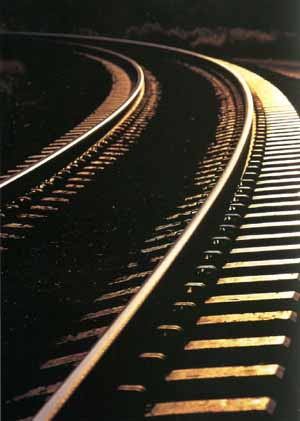
Modern track uses continuous welded rail and concrete
ties. This type of track requires modern f to hold the rail firmly to
the tie.
Old-fashioned jointed rail has largely given way to continuous welded rail, which usually comes in 1,500-foot-long sections. Welded rail has many advantages over jointed rail. The inherent unevenness of rail joints results in more wear to wheels and related components. The constant pounding of the wheels against the rail joints is also damaging to the rail ends and to the joints themselves. Eliminating the joints reduces maintenance and produces a smoother ride while minimizing wear to wheels and other equipment. Welded rail has its own set of problems, however. One of the primary difficulties with welded rail relates to the effects of expansion and con traction already discussed. During times of extreme temperature change, welded rail is more likely to develop serious heat kinks. In the most extreme circumstances, this will cause the rail to violently spring loose from the track structure. If this occurs below the wheels of a moving train, the results can be disastrous. Conversely, in times of extreme cold weather, rail shrinkage can lead to “pull aparts,” where the rail sections actually separate from one another, leaving a sizable gap in the tracks. This dangerous situation can lead to a derailment.
These problems can be avoided by proper installation and by ensuring that there are sufficient fasteners to hold the rail in place. With proper fastening, expansion will occur in the rail width rather than the lengthwise expansion that can cause buckling. Rail is under its greatest tension on the outside of curves and is more likely to buckle on a curve than on straight sections of track, particularly curves located at the bottom of a grade. As a result, extra spikes rail anchors, or fastening clips are needed to secure steeply curving track. Even with proper installation, regular track inspection to look for signs of weakness is key to avoiding major problems.
Another difficulty with welded rail has to do with routine maintenance. Jointed rail is relatively easy-to adjust, replace, and repair, since the 39- foot-long sections can be replaced by a typical track gang of just a dozen or so men. Without need for complicated machinery, a track gang can lift these sections into place and spike them down fairly quickly. When a serious defect is found on a rail section, the Section can easily be replaced with a new one. Such replacement is not as simple with welded rail, and even basic maintenance procedures are more involved. When a quarter-mile- long rail develops a crack or other defect, it is impractical to change the entire segment. Instead, the defective portion of rail must be cut out and a replacement piece welded or bolted in place. While such repairs are routine, they can take more time and effort than simply replacing a standard 39-foot section. The procedure for replacing welded rail is relatively complex, involving portable welding kits that use a flammable chemical compound.

Lengths of continuous welded rail are transported
on specially designed trains consisting of a string of flat cars with
racks. Welded rail is flexible and can easily negotiate curves as the
train rolls along.
Crossties
Crossties (usually described as simply “ties”), spikes, tie plates, and anchors are the track components that hold the rails in place and in gauge while they support the weight of the train. Like the rail itself, these components have gradually evolved into their modern form, yet have close historical connections to early track components. The days of the cut-stone sleeper have long since passed, and though wood has proven to be one of the best and most versatile materials for rail road ties, it has been supplemented by other materials. Many different types of wood have been used for ties over the years, but treated hard woods are now preferred for their stability, durability, and longevity.
In the 1930s, the American Railway Engineering Association listed 27 types of wood as suitable for use as railway ties. Among them were cherry, chestnut, elm, hemlock, hickory, oak, and walnut. A number of softwoods were also listed, including various pines, firs, and redwood Ac cording to the fifth edition of the Elements of Rail road En between 1925 and 1934 the most common type of wood for ties was oak; roughly 199,163,190 oak ties were in use at that time in the United States, or 37 percent of all ties, which totaled 538,667,703 (give or take a few here and there). Southern pine accounted for 24.5 percent of all ties, and Douglas fir for 9.6 percent; all other types of wood constituted a much less significant portion of the total. Hardwood ties have good tension characteristics, which allow them to grip spikes well, yet they are sufficiently flexible to cushion the impact of a rolling train.
Early railroads used whatever kind of wood was available for ties. The ties were cut by hand and often left unfinished. Looking at photos of early tracks, it is interesting to note that the ties were sometimes little more than logs below the rails. They varied considerably in length and width, and sometimes even still had bits of bark on them. Untreated ties made from inferior types of wood, such as cottonwood, disintegrated quickly and needed replacement just a few years after they were installed. By contrast, hardwood ties treated with creosote can have a remarkably long life, and some can last for more than 60 years. Creosote and pressure treatments are used to make ties water-resistant and to help retard decay.
Traditionally when ties were installed a date nail was placed in the ties to help the maintainers of the track gauge how long the ties were in ser vice, and when they should be replaced. In later years, instead of the date nails, ties were branded with the date of installation. Although date nails have been out of fashion for decades, they can still be found on ties used for sidings, yard tracks, and secondary mainlines. A close inspection of track may reveal nails from the 1930s and 1940s and even earlier, which gives one an appreciation for how long wooden ties can last in daily service. Today, ties are mass-produced to predetermined specifications, finished on all sides, and treated to minimize decay and extend their service life. A new wooden tie appears nearly black and is remarkably uniform.
In recent times, reinforced concrete ties, and even steel ties and plastic ties have come into general use. Concrete ties are more expensive than wooden ties, but they are designed for long life under high-stress conditions. Tracks built with concrete ties offer greater stability, since concrete ties are significantly heavier than conventional wooden ties, weighing up to three times as much. Concrete ties are typically preferred on lines with very heavy tonnage like the coal lines in the Powder River Basin, and on high-speed routes, such as Amtrak’s Northeast Corridor, and super fast lines in Europe and Japan.

Many different types of wood can be used for crossties,
although oak is generally preferred. A wooden tie ought to last for several
decades. The tie serves to hold the rails in gauge while distributing
the weight of the train.
Spikes, Tie Plates, and Anchors
Making sure that the rails are properly fastened to the ties is a very important consideration to ensure that tracks remain in gauge under varying degrees of stress. Traditionally rails were se cured to wooden ties using track spikes. As the size and weight of rail has grown over the years, so has the size of the spikes. Spikes hold the rails to the ties and limit sideways movement. In the early days, rails were fastened directly to the ties, but today a tie plate made from rolled steel is placed between the rail and the tie. A tie plate is designed to seat the rail on the tie, while helping to spread the weight of the train and the rail over a larger area on the tie. This prolongs the useful life of the tie by minimizing wear, gives the rail additional support, and provides a sound base to spike the rail in place. A tie plate is wide and flat. Ideally the tie plate is broader on the field side to accommodate the great stress that is placed on the outside of the rail by the forces of a passing train. To further check these forces, the plate seat is angled slightly to position the rail inward to ward the track center. The rail is seated between tapered shoulders, with a distinct lip designed to restrain lateral rail motion.
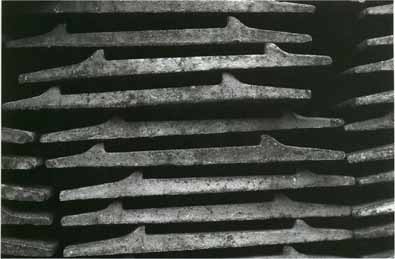
This stack of surplus tie plates shows them in profile.
A tie plate is designed to hold the rail in place, helps distribute the
weight of the train over a broader area of the tie, and prolongs the
life of the tie. When the tie plate is placed on the track, the larger
side faces outward to provide greater support on the outside of the rail.
Typically a rail is seated on the tie plate and spiked in place with two to eight spikes placed in precut holes in the plate. The number of spikes used depends on a variety of considerations, including the position of the rail, the top speed of the trains, train frequency, and maximum weight. Rail located on the outside of a curve at the bottom of a heavily traveled mainline grade will require more spikes than on lightly used tangent track.
Augmenting the rail spike and tie plate is the rail anchor. This longitudinal clip is fastened to the base of the rail between and parallel to the ties to restrict the lengthwise motion of the rail. Without rail anchors, the rail would slide along the tie plates as a result of forces placed upon it by passing trains, as well as from the natural swelling and con traction caused by temperature fluctuations.
Some modern track designs use specially de signed spring clip fasteners instead of traditional spikes and rail anchors, The most common of these is manufactured by Pandrol. Known as the “Pandrol fastener,” it resembles an enormous steel paper clip. These clips are attached to specially designed tie plates, which are held to wooden ties using large screws. A number of other modern fasteners are also used in place of spikes and rail anchors.
In addition to these fasteners, rail braces are applied to switches and sharp curves where abnormally high lateral forces are exerted against the rail. Normally braces are used just to support the outer rail in a curve, but they are sometimes placed on the inner rail as well. Braces are typically manufactured from either cast or pressed steel and held in place with spikes or track screws.
Tracks built using concrete ties have different fastening requirements than conventional track using wooden ties. Rail is attached to concrete ties with a special style of clip-like fastener that connects to steel plates cast into the tie. Cushioned pads are inserted between the rail and the tie. Since concrete ties are much stronger and heavier than wooden ties, they can be spaced further apart.
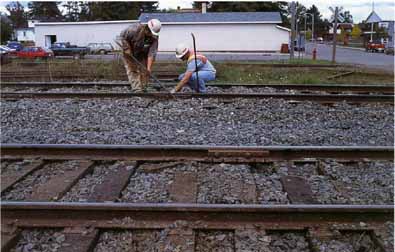
A maintenance gang prepares a section of track for
tamping. The two new ties on the track in the foreground are evidence
that a tie gang has just been through. A little ballast has been spread
over the tracks, but has not been attended to by a regulator.
Ballast, Sub-ballast, and Sub-grade
The ties on a railroad track are set into bal last, which has several important functions First, ballast is integral to the track structure and keeps the ties in place, countering forces placed on the ties by rail expansion and passing trains. Secondly, ballast must support the track and distribute the load it carries from the tie bottoms. The force transferred from tie to ballast is considerable. John H. Armstrong indicates in his book, The Railroad What It Is, What It Does, that under load, the average pressure below each tie is 100 psi. The third important function of ballast is to quickly and efficiently drain water away from the track structure, as standing water can rapidly damage tracks. Ballast also acts to keep down vegetation that might interfere with the track structure. Bal last must do all these things, yet also remain flexible and easy to work with, so that track repairs, such as tie and rail renewal and tamping, can be conducted with minimal difficulty.
Why is it called ballast anyway? Like so many specialized elements of railroad technology, rail road ballast derives its name from marine ship ping. Traditionally, ballast referred to stones used to weigh down a ship.
A variety of materials have been used for rail road ballast over the years. The earliest lines bal lasted tracks with earth and loose stones. During the mid-nineteenth century, cinders dumped from locomotive fireboxes served as typical ballast. Today crushed stone is the most common ballast material, although the size and type of stone used by each railroad varies with availability and the nature of the lines. Gravel and crushed-stone bal last has the added advantage that it locks together, inhibiting track movement.
Ballast is placed between, below, and around the ties to keep them in place. The amount of bal last applied to a section of track varies, depending on the size and spacing of the ties, the amount of traffic expected over the line, whether the track is straight or curved, and other factors. A typical single-track tangent line has ballast laid even with the tops of the ties extending 14 inches beyond either side of the ties on the level, then tapering off at a 3- to-I slope extending up to 9 feet, 10 inches beyond the track center. The depth of this top ballast layer extends 1 foot below the bottom of the ties. Additional ballast beyond this is considered the sub-bal last and is treated as a separate track component.
The sub-ballast, typically small crushed stones, provides solid support for the top ballast. It also seals out water from the sub-grade to pre vent it from saturating. The sub-grade is the layer below the sub-ballast, typically the earth and stones underneath the track, If the sub-grade be comes saturated with water, the pumping action caused by a passing train will rapidly undermine the structural integrity of the ballast, ties, and rail, causing long-term damage that can ultimately result in a derailment.